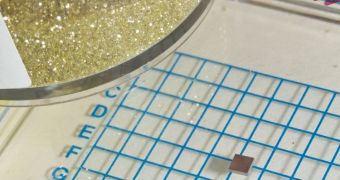Investigators at the Harvard University announce the development of a new type of nanostructures, which they say could be of great potential use for the development of future quantum computers. The team says that a host of other high-tech applications are also possible
The investigation built on previous work, which demonstrated that individual photons could be emitted from impure diamond crystal nanowires. In the new investigation, researchers developed silver-planet diamond posts, which are apparently capable of producing single photons as well.
In addition, the material can also be used to control the speed at which individual photons are being released, something that was impossible with previous types of material. Physicists say that light could be used to read and write quantum-based data at great speeds.
Researchers have been working towards creating a quantum computer for many years, but numerous challenges still remain. Learning how to store and retrieve data at great speeds, but without spoiling or observing its quantum state, is just one of the issues to be solved.
However, the new study could finally enable researchers to build quantum computers that do not require being cooled to nearly absolute zero in order to display superposition and entanglement. These are the main two traits that separate quantum system for any other kind of system.
“Luminescent imperfections in diamond, and nitrogen-vacancy color centers in particular, have recently emerged as a promising building block for realization of scalable, on-chip, quantum networks and sensitive magnetometers, owing to excellent 'memory' in a nitrogen vacancy's spin,” Marko Loncar explains.
The Harvard electrical engineer was the lead author of the new study detailing the findings, which was published in the October 9 issue of the top scientific journal Nature Photonics. A number of students and a postdoctoral researcher at Harvard were also a part of the research.
“Color centers in diamond arise from defects or atomic impurities in the crystal lattice, resulting in the luminescence we see in some bulk diamond crystals,” Harvard student and study coauthor Jennifer Choy explains. She holds an appointment as a researcher in Loncar's lab.
“Certain color centers, including the nitrogen-vacancy center used in this work, are quantum emitters that release single photons, which are coupled to electronic (and nuclear) spin states and can be used to encode, store, communicate and finally read-out information,” she adds.
“Single photon emission in such systems is generally robust even at room temperature, which makes diamond-based devices enticing for the creation of an on-chip quantum network,” Choy concludes.
Part of the new study was funded by the US National Science Foundation (NSF).

 14 DAY TRIAL //
14 DAY TRIAL //